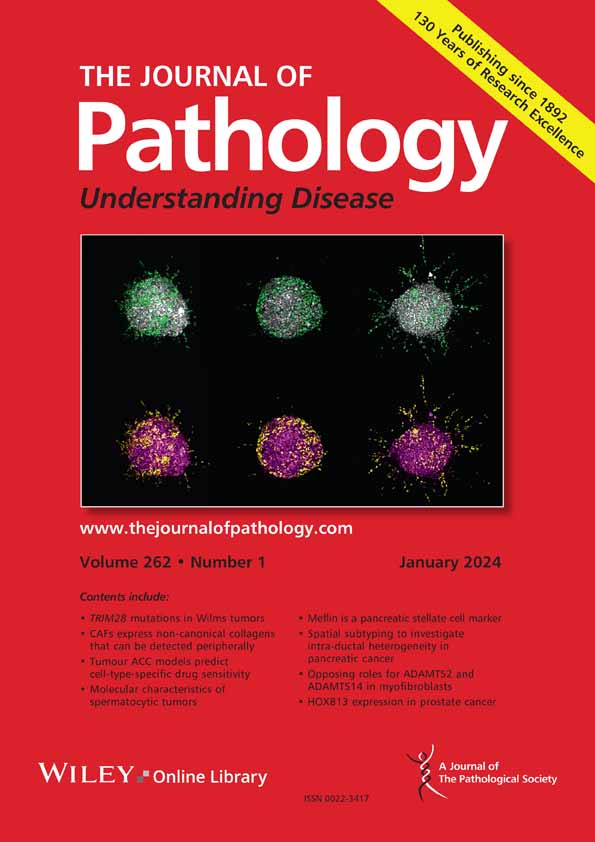Christopher Felicelli, Xinyan Lu, Zachary Coty-Fattal, Yue Feng, Ping Yin, Matthew John Schipma, Julie J Kim, Lawrence J Jennings, Serdar E Bulun, Jian-Jun Wei
下载PDF
{"title":"异核平滑肌瘤所致子宫平滑肌肉瘤的基因组特征及组织学分析。","authors":"Christopher Felicelli, Xinyan Lu, Zachary Coty-Fattal, Yue Feng, Ping Yin, Matthew John Schipma, Julie J Kim, Lawrence J Jennings, Serdar E Bulun, Jian-Jun Wei","doi":"10.1002/path.6379","DOIUrl":null,"url":null,"abstract":"<p>Leiomyoma with bizarre nuclei (LM-BN) is a rare variant of leiomyoma with a benign clinical course. In contrast, leiomyosarcoma (LMS) is a high-grade, malignant neoplasm characterized by high recurrence rates and poor survival. While LM-BN and LMS show distinct morphologies, they share similar immunoprofiles and molecular alterations, with both considered ‘genomically unstable’. Rare cases of LM-BN associated with LMS have been reported; however, the histogenesis and molecular relationship between these two tumors remains unclear. In this study, we assessed 11 cases of LMS arising in conjunction with LM-BN confirmed by histology and immunohistochemistry (IHC), further analyzed by clinical, histologic, and molecular characteristics of these distinct components. LM-BN and LMS had similar p16 and p53 IHC patterns, but LMS had a higher Ki-67 index and lower estrogen and progesterone eceptor expression. Digital image analysis based on cytologic features revealed spatial relationships between LMS and LM-BN. Genomic copy number alterations (CNAs) demonstrated the same clonal origin of LMS arising from existing LM-BN through conserved CNAs. LMS harbored highly complex CNAs and more frequent losses of the <i>TP53</i>, <i>RB1</i>, and <i>PTEN</i> genomic regions than LM-BN (<i>p</i> = 0.0031), with <i>CDKN2A/B</i> deletion identified in LMS only. Mutational profiling revealed many shared oncogenic alterations in both LM-BN and LMS; however, additional mutations were present within LMS, indicative of tumor progression through progressive genomic instability. Analysis of spatial transcriptomes defined uniquely expressed gene signatures that matched the geographic distribution of LM-BN, LMS, and other cell types. Our findings indicate for the first time that a subset of LMS arises from an existing LM-BN, and highly complex genomic alterations could be potential high risks associated with disease progression in LM-BN. © 2024 The Author(s). <i>The Journal of Pathology</i> published by John Wiley & Sons Ltd on behalf of The Pathological Society of Great Britain and Ireland.</p>","PeriodicalId":232,"journal":{"name":"The Journal of Pathology","volume":"265 2","pages":"211-225"},"PeriodicalIF":5.2000,"publicationDate":"2024-12-18","publicationTypes":"Journal Article","fieldsOfStudy":null,"isOpenAccess":false,"openAccessPdf":"https://www.ncbi.nlm.nih.gov/pmc/articles/PMC11717496/pdf/","citationCount":"0","resultStr":"{\"title\":\"Genomic characterization and histologic analysis of uterine leiomyosarcoma arising from leiomyoma with bizarre nuclei\",\"authors\":\"Christopher Felicelli, Xinyan Lu, Zachary Coty-Fattal, Yue Feng, Ping Yin, Matthew John Schipma, Julie J Kim, Lawrence J Jennings, Serdar E Bulun, Jian-Jun Wei\",\"doi\":\"10.1002/path.6379\",\"DOIUrl\":null,\"url\":null,\"abstract\":\"<p>Leiomyoma with bizarre nuclei (LM-BN) is a rare variant of leiomyoma with a benign clinical course. In contrast, leiomyosarcoma (LMS) is a high-grade, malignant neoplasm characterized by high recurrence rates and poor survival. While LM-BN and LMS show distinct morphologies, they share similar immunoprofiles and molecular alterations, with both considered ‘genomically unstable’. Rare cases of LM-BN associated with LMS have been reported; however, the histogenesis and molecular relationship between these two tumors remains unclear. In this study, we assessed 11 cases of LMS arising in conjunction with LM-BN confirmed by histology and immunohistochemistry (IHC), further analyzed by clinical, histologic, and molecular characteristics of these distinct components. LM-BN and LMS had similar p16 and p53 IHC patterns, but LMS had a higher Ki-67 index and lower estrogen and progesterone eceptor expression. Digital image analysis based on cytologic features revealed spatial relationships between LMS and LM-BN. Genomic copy number alterations (CNAs) demonstrated the same clonal origin of LMS arising from existing LM-BN through conserved CNAs. LMS harbored highly complex CNAs and more frequent losses of the <i>TP53</i>, <i>RB1</i>, and <i>PTEN</i> genomic regions than LM-BN (<i>p</i> = 0.0031), with <i>CDKN2A/B</i> deletion identified in LMS only. Mutational profiling revealed many shared oncogenic alterations in both LM-BN and LMS; however, additional mutations were present within LMS, indicative of tumor progression through progressive genomic instability. Analysis of spatial transcriptomes defined uniquely expressed gene signatures that matched the geographic distribution of LM-BN, LMS, and other cell types. Our findings indicate for the first time that a subset of LMS arises from an existing LM-BN, and highly complex genomic alterations could be potential high risks associated with disease progression in LM-BN. © 2024 The Author(s). <i>The Journal of Pathology</i> published by John Wiley & Sons Ltd on behalf of The Pathological Society of Great Britain and Ireland.</p>\",\"PeriodicalId\":232,\"journal\":{\"name\":\"The Journal of Pathology\",\"volume\":\"265 2\",\"pages\":\"211-225\"},\"PeriodicalIF\":5.2000,\"publicationDate\":\"2024-12-18\",\"publicationTypes\":\"Journal Article\",\"fieldsOfStudy\":null,\"isOpenAccess\":false,\"openAccessPdf\":\"https://www.ncbi.nlm.nih.gov/pmc/articles/PMC11717496/pdf/\",\"citationCount\":\"0\",\"resultStr\":null,\"platform\":\"Semanticscholar\",\"paperid\":null,\"PeriodicalName\":\"The Journal of Pathology\",\"FirstCategoryId\":\"3\",\"ListUrlMain\":\"https://pathsocjournals.onlinelibrary.wiley.com/doi/10.1002/path.6379\",\"RegionNum\":2,\"RegionCategory\":\"医学\",\"ArticlePicture\":[],\"TitleCN\":null,\"AbstractTextCN\":null,\"PMCID\":null,\"EPubDate\":\"\",\"PubModel\":\"\",\"JCR\":\"Q1\",\"JCRName\":\"ONCOLOGY\",\"Score\":null,\"Total\":0}","platform":"Semanticscholar","paperid":null,"PeriodicalName":"The Journal of Pathology","FirstCategoryId":"3","ListUrlMain":"https://pathsocjournals.onlinelibrary.wiley.com/doi/10.1002/path.6379","RegionNum":2,"RegionCategory":"医学","ArticlePicture":[],"TitleCN":null,"AbstractTextCN":null,"PMCID":null,"EPubDate":"","PubModel":"","JCR":"Q1","JCRName":"ONCOLOGY","Score":null,"Total":0}
引用次数: 0
引用
批量引用





 求助内容:
求助内容: 应助结果提醒方式:
应助结果提醒方式:


